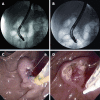Double guidewire technique vs transpancreatic precut sphincterotomy in difficult biliary cannulation
- PMID: 23326171
- PMCID: PMC3542752
- DOI: 10.3748/wjg.v19.i1.108
Double guidewire technique vs transpancreatic precut sphincterotomy in difficult biliary cannulation
Abstract
Aim: To compare the outcomes between double-guidewire technique (DGT) and transpancreatic precut sphincterotomy (TPS) in patients with difficult biliary cannulation.
Methods: This was a prospective, randomized study conducted in single tertiary referral hospital in Korea. Between January 2005 and September 2010. A total of 71 patients, who bile duct cannulation was not possible and selective pancreatic duct cannulation was achieved, were randomized into DGT (n = 34) and TPS (n = 37) groups. DGT or TPS was done for selective biliary cannulation. We measured the technical success rates of biliary cannulation, median cannulation time, and procedure related complications.
Results: The distribution of patients after randomization was balanced, and both groups were comparable in baseline characteristics, except the higher percentage of endoscopic nasobiliary drainage in the DGT group (55.9% vs 13.5%, P < 0.001). Successful cannulation rate and mean cannulation times in DGT and TPS groups were 91.2% vs 91.9% and 14.1 ± 13.2 min vs 15.4 ± 17.9 min, P = 0.732, respectively. There was no significant difference between the two groups. The overall incidence of post- endoscopic retrograde cholangiopancreatography (ERCP) pancreatitis was 38.2% vs 10.8%, P < 0.011 in the DGT group and the TPS group; post-procedure pancreatitis was significantly higher in the DGT group. But the overall incidence of post-ERCP hyperamylasemia was no significant difference between the two groups; DGT group vs TPS group: 14.7% vs 16.2%, P < 1.0.
Conclusion: When free bile duct cannulation was difficult and selective pancreatic duct cannulation was achieved, DGT and TPS facilitated biliary cannulation and showed similar success rates. However, post-procedure pancreatitis was significantly higher in the DGT group.
Keywords: Duoble guidewire technique; Endoscopic retrograde cholangiopancreatography; Post-endoscopic retrograde cholangiopancreatography pancreatitis; Transpancrestic precut sphincterotomy.
Figures


Similar articles
-
Transpancreatic Sphincterotomy Is Effective and Safe in Expert Hands on the Short Term.Dig Dis Sci. 2019 Sep;64(9):2429-2444. doi: 10.1007/s10620-019-05640-4. Epub 2019 May 4. Dig Dis Sci. 2019. PMID: 31055720 Free PMC article.
-
Sequential double-guidewire technique and transpancreatic precut sphincterotomy for difficult biliary cannulation.Saudi J Gastroenterol. 2015 Jan-Feb;21(1):18-24. doi: 10.4103/1319-3767.151212. Saudi J Gastroenterol. 2015. PMID: 25672234 Free PMC article.
-
Precut Over a Pancreatic Duct Stent Versus Transpancreatic Precut Sphincterotomy for Difficult Biliary Cannulation in Endoscopic Retrograde Cholangiopancreatography: A Retrospective Cohort Study.Dig Dis Sci. 2024 Oct;69(10):3962-3969. doi: 10.1007/s10620-024-08603-6. Epub 2024 Aug 31. Dig Dis Sci. 2024. PMID: 39215869 Free PMC article.
-
Comparison of sequential pancreatic duct guidewire placement technique and needle knife precut sphincterotomy for difficult biliary cannulation.J Dig Dis. 2015 Dec;16(12):741-6. doi: 10.1111/1751-2980.12300. J Dig Dis. 2015. PMID: 26562073
-
Transpancreatic sphincterotomy has a higher cannulation success rate than needle-knife precut papillotomy - a meta-analysis.Endoscopy. 2017 Sep;49(9):874-887. doi: 10.1055/s-0043-111717. Epub 2017 Jun 13. Endoscopy. 2017. PMID: 28609791 Review.
Cited by
-
Transpancreatic Sphincterotomy Is Effective and Safe in Expert Hands on the Short Term.Dig Dis Sci. 2019 Sep;64(9):2429-2444. doi: 10.1007/s10620-019-05640-4. Epub 2019 May 4. Dig Dis Sci. 2019. PMID: 31055720 Free PMC article.
-
Pancreatic duct guidewire placement for biliary cannulation for the prevention of post-endoscopic retrograde cholangiopancreatography (ERCP) pancreatitis.Cochrane Database Syst Rev. 2016 May 16;2016(5):CD010571. doi: 10.1002/14651858.CD010571.pub2. Cochrane Database Syst Rev. 2016. PMID: 27182692 Free PMC article.
-
Predictive factors of difficult biliary cannulation: An experience of a tunisian tertiary center.Heliyon. 2022 Dec 22;8(12):e12526. doi: 10.1016/j.heliyon.2022.e12526. eCollection 2022 Dec. Heliyon. 2022. PMID: 36619425 Free PMC article.
-
Primary Needle-Knife Sphincterotomy for Biliary Access in Patients at High Risk of Post-Endoscopic Retrograde Cholangiopancreatography Pancreatitis.Gastroenterol Res Pract. 2021 May 18;2021:6662000. doi: 10.1155/2021/6662000. eCollection 2021. Gastroenterol Res Pract. 2021. PMID: 34054945 Free PMC article.
-
Sequential double-guidewire technique and transpancreatic precut sphincterotomy for difficult biliary cannulation.Saudi J Gastroenterol. 2015 Jan-Feb;21(1):18-24. doi: 10.4103/1319-3767.151212. Saudi J Gastroenterol. 2015. PMID: 25672234 Free PMC article.
References
-
- Ramirez FC, Dennert B, Sanowski RA. Success of repeat ERCP by the same endoscopist. Gastrointest Endosc. 1999;49:58–61. - PubMed
-
- Freeman ML, Nelson DB, Sherman S, Haber GB, Herman ME, Dorsher PJ, Moore JP, Fennerty MB, Ryan ME, Shaw MJ, et al. Complications of endoscopic biliary sphincterotomy. N Engl J Med. 1996;335:909–918. - PubMed
-
- Vandervoort J, Soetikno RM, Tham TC, Wong RC, Ferrari AP, Montes H, Roston AD, Slivka A, Lichtenstein DR, Ruymann FW, et al. Risk factors for complications after performance of ERCP. Gastrointest Endosc. 2002;56:652–656. - PubMed
-
- Masci E, Mariani A, Curioni S, Testoni PA. Risk factors for pancreatitis following endoscopic retrograde cholangiopancreatography: a meta-analysis. Endoscopy. 2003;35:830–834. - PubMed
-
- Dumonceau JM, Devière J, Cremer M. A new method of achieving deep cannulation of the common bile duct during endoscopic retrograde cholangiopancreatography. Endoscopy. 1998;30:S80. - PubMed
Publication types
MeSH terms
LinkOut - more resources
Full Text Sources
Other Literature Sources
Medical

